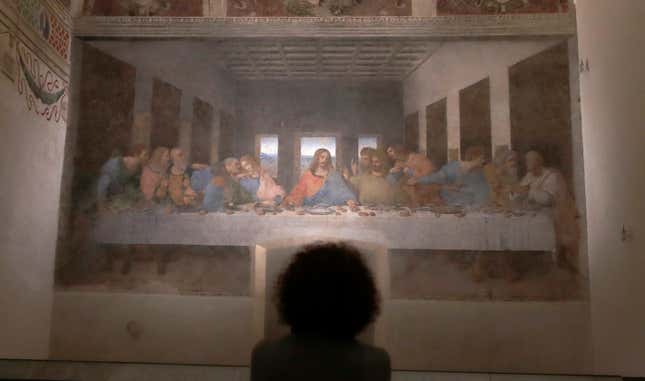
An extensive reworking of the family tree of Leonardo da Vinci connects an unbroken male line that extends from the artist’s grandfather to 14 living descendants—a 690-year span that encompasses 21 generations.
The new study, published in Human Evolution, adds significant clarity to the Da Vinci family tree, in a project that began in the early 1970s. The authors of the new paper, art historians Alessandro Vezzosi and Agnese Sabato, say their findings will now be cross-referenced with genetic data belonging to living and deceased members of Leonardo da Vinci’s family. Excitingly, the upcoming DNA study could shed new light on the man himself, the authors argue.
The famed Renaissance artist, architect, and inventor never had any children of his own, but Leonardo had at least 22 half brothers, as he was born out of wedlock. Newly accessed historical documents and sources allowed Vezzosi and Sabato to trace the male line all the way to Leonardo’s great-great-great grandfather, Michele (first generation), who was born in 1331. Leonardo himself, from the sixth generation, was born on April 15, 1452 and is famous for such works as the Mona Lisa, The Last Supper, and the Vitruvian Man.
The newly updated family tree consists of five major branches, which the researchers trace from Leonardo’s father, Ser Piero, and half-brother, Domenico. The team documented a continuous male line that spans 21 generations and includes 14 living descendants—the youngest of which is just 1 year old. Of these 14, only one was previously known to the team.
“They are aged between one and 85, they don’t live right in Vinci but in neighbouring municipalities as far as Versilia (on the Tuscan coast) and they have ordinary jobs like a clerk, a surveyor, an artisan,” Vezzosi told Italian new outlet Ansa.
Five years ago, the same team identified 35 living relatives of Leonardo, including some from the female line, but they were mostly indirect, according to the Guardian. The multi-year project involves the Museo Ideale Leonardo Da Vinci, the Leonardo da Vinci Heritage Association, the J. Craig Venter Institute of La Jolla, California, among other institutions.
The new research now sets the stage for a genetic analysis involving the Y chromosome, which gets passed down exclusively to male descendants.
“Like the surname, male heredity connects the history of registry records with biological history along separate lineages,” reads the study’s abstract. “Because of this, the present genealogy, which spans almost seven hundred years, can be used to verify, by means of the most innovative technologies of molecular biology, the unbroken transmission of the Y chromosome (through the living descendants and ancient tombs, even if with some small variations due to time) with a view to confirming the recovery of Leonardo’s Y marker.”
Interestingly, the recovery and confirmation of Leonardo’s Y chromosome could reveal new insights into his family’s geographic origin, genetic health, and possibly even the presence of synesthesia. Theoretically, Da Vinci’s biological data could also help to verify the authenticity of his artworks.
Leonardo was buried in France in 1519, but the current location of his remains is uncertain. DNA of his living relatives will be analyzed in the coming months, potentially leading to new insights about the famous artist and his family.
Correction: A previous version of this article incorrectly described Michele as Leonardo da Vinci’s grandfather; he was actually his great-great-great grandfather. Thanks to the commenters for pointing out the implausible age gap.
More: MIT confirms a bridge Leonardo da Vinci designed 500 years ago was an ancient engineering marvel.